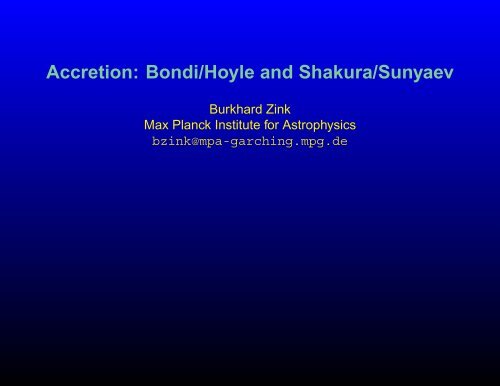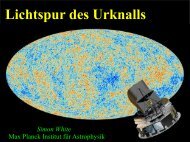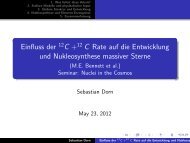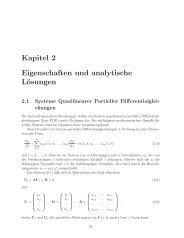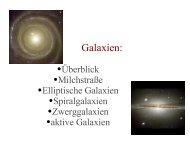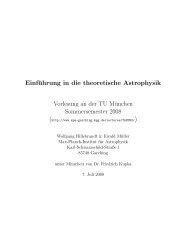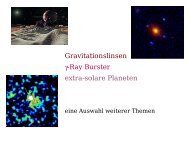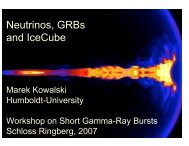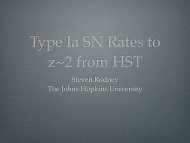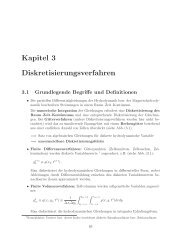Bondi/Hoyle and Shakura/Sunyaev - Max-Planck-Institut für ...
Bondi/Hoyle and Shakura/Sunyaev - Max-Planck-Institut für ...
Bondi/Hoyle and Shakura/Sunyaev - Max-Planck-Institut für ...
You also want an ePaper? Increase the reach of your titles
YUMPU automatically turns print PDFs into web optimized ePapers that Google loves.
Accretion: <strong>Bondi</strong>/<strong>Hoyle</strong> <strong>and</strong> <strong>Shakura</strong>/<strong>Sunyaev</strong><br />
Burkhard Zink<br />
<strong>Max</strong> <strong>Planck</strong> <strong>Institut</strong>e for Astrophysics<br />
bzink@mpa-garching.mpg.de
1. Introduction <strong>and</strong> motivation<br />
2. Spherical accretion<br />
3. Disk accretion<br />
4. General relativistic torus accretion<br />
Overview<br />
1
Literature<br />
• This talk is based on ch. 14 of Shapiro, Teukolsky: Black Holes, White<br />
Dwarfs <strong>and</strong> Neutron Stars (John Wiley & Sons)<br />
• Much more information can be found in Frank, King, Raine: Accretion<br />
Power in Astrophysics (Cambridge University Press)<br />
2
1. Introduction <strong>and</strong> motivation<br />
3
Accretion onto compact objects<br />
• Accretion is inflow of matter onto compact objects by gravitational forces<br />
<strong>and</strong> transport of angular momentum<br />
• Compact objects: White dwarfs, neutron stars, black holes<br />
• Important, because accretion can be much more effective in converting<br />
rest-mass into radiation than e.g. fusion<br />
• Complex physical process: (magneto-) hydrodynamics, radiative transfer,<br />
special or general relativity, chemistry <strong>and</strong> atomic physics<br />
• In this talk: only simple scenarios under consideration<br />
4
Astrophysical relevance<br />
• Accreted matter will heat up ⇒ EM radiation<br />
• Effectively this is a conversion of gravitational binding energy (Newtonian<br />
viewpoint) or rest-mass (GR viewpoint) into radiation flux<br />
• Primary radiation may be reprocessed (e.g. in AGN cores)<br />
• More complex accretion models seek also to explain the core engine of jets<br />
in AGN or microquasars<br />
5
Models of accretion<br />
• Analytical models: Strong simplification of the accretion problem<br />
• Possible assumptions:<br />
⋆ Special relativistic or Newtonian mechanics<br />
⋆ One particle species for the mechanics<br />
⋆ No magnetic fields<br />
⋆ Macroscopic charge neutrality<br />
⋆ Hydrodynamic description with stationary flow<br />
⋆ Further symmetries <strong>and</strong> accretion geometries<br />
6
Models of accretion<br />
Model Assumptions<br />
Zel’dovich/Novikov Newtonian mechanics,<br />
collisionless gas (Vlasov equation)<br />
spherical symmetry<br />
<strong>Bondi</strong>/<strong>Hoyle</strong> Newtonian mechanics,<br />
adiabatic fluid (HD),<br />
spherical symmetry<br />
<strong>Shakura</strong>/<strong>Sunyaev</strong> Newtonian mechanics,<br />
viscous fluid (HD),<br />
simple radiative transfer,<br />
axisymmetry, disk geometry<br />
Michel GR mechanics,<br />
adiabatic fluid (HD),<br />
spherical symmetry<br />
Other Newtonian <strong>and</strong> GR models<br />
of accretion disks<br />
7
2. Spherical accretion<br />
8
<strong>Bondi</strong>/<strong>Hoyle</strong> accretion<br />
• Newtonian mechanics, central potential for gravity<br />
• Hydrodynamic flow, spherical symmetry, stationarity ⇒ 1D problem<br />
• Self-gravitation of accreted matter is neglected<br />
• Adiabatic, non-viscous fluid<br />
• No radiative transfer<br />
• Accretion sphere is stabilized by pressure gradients<br />
9
Flow description<br />
• 1D radial flow: characterised by density ρ(r), velocity u(r) <strong>and</strong> pressure<br />
P (r)<br />
• HD equations for 1D adiabatic, non-viscous problems:<br />
Continuity<br />
3D Radial (1D)<br />
∂ρ<br />
∂t<br />
Momentum ∂<br />
∂t<br />
+ ∇(ρu) = 0<br />
1<br />
1<br />
u + (u∇)u = ρ∇P − ∇Φ udu<br />
dr<br />
d<br />
r2 dr (r2ρu) = 0<br />
dP = −1<br />
ρ dr<br />
EOS P = Kρ Γ P = Kρ Γ<br />
− GM<br />
r 2<br />
10
<strong>Bondi</strong> equations<br />
• The <strong>Bondi</strong> equations are the integrated version of the radial hydro<br />
equations:<br />
Continuity 4πr 2 ρu = ˙ M<br />
Momentum 1<br />
2u2 + 1<br />
Γ−1a2 − GM<br />
r<br />
1 2 = Γ−1a∞ • Here we have used u∞ = 0 <strong>and</strong> the sound speed: a = dP/dρ<br />
• Given boundary conditions at infinity <strong>and</strong> at the surface of the CO, we can<br />
determine flow solutions<br />
• A solution consists of u(r) <strong>and</strong> ρ(r)<br />
11
• u(r) at small radii: free-fall speed<br />
Spherical black hole accretion<br />
• <strong>Bondi</strong> equations can be solved <strong>and</strong> show the existence of a transsonic<br />
radius (⇒ transsonic accretion)<br />
• At the transsonic radius the accretion gets supersonic<br />
• For general boundary conditions also subsonic accretion <strong>and</strong> wind (outflow)<br />
solutions of the <strong>Bondi</strong> equations exist<br />
12
Radiation from <strong>Bondi</strong>/<strong>Hoyle</strong> accretion onto black holes<br />
• Determining radiation efficiency is very important: We want to relate the<br />
accretion rate to luminosity<br />
• Because the <strong>Bondi</strong>/<strong>Hoyle</strong> scenario is adiabatic, we neglect back-reactions<br />
of the radiation on the flow<br />
• Dominant emission process is thermal bremsstrahlung, which depends on<br />
density <strong>and</strong> temperature<br />
• The emission is dominated by the flow near the event horizon (high density<br />
<strong>and</strong> temperature)<br />
• Result: <strong>Bondi</strong>/<strong>Hoyle</strong> is inefficient accretion process for black hole boundary<br />
conditions:<br />
ɛ = L<br />
M<br />
≈ 6 · 10−11<br />
˙Mc 2 M⊙<br />
13
3. Disk accretion<br />
14
<strong>Shakura</strong>/<strong>Sunyaev</strong> accretion<br />
• Newtonian mechanics, central potential for gravity<br />
• Hydrodynamic flow, axisymmetric disk geometry, stationarity ⇒ 1D problem<br />
• Disk is stabilized by centrifugal forces<br />
• Self-gravitation of accreted matter is neglected<br />
• Non-adiabatic, viscous fluid<br />
• Simple radiative transfer<br />
15
Disk accretion: General features<br />
• Accreted matter may have angular momentum ⇒ high angular velocity uφ<br />
near the CO<br />
• Accretion disk consists of rings of nearly Keplerian orbits<br />
• lKepler ∝ √ r ⇒ inward motion only possible through transport of angular<br />
momentum (slow)<br />
• Thus matter has much time to radiate binding energy away<br />
• Much more efficient at generating luminosity than spherical accretion!<br />
• Viscosity has two functions here:<br />
⋆ Transport of angular momentum<br />
⋆ Heat generation<br />
16
Towards a model of thin accretion disks<br />
• Thin disk means h(r) ≪ r<br />
• Approximate vertical equations by taking mean values or finite differences<br />
• <strong>Shakura</strong>/<strong>Sunyaev</strong> thin disk model is a solution of a system of nine<br />
equations:<br />
⋆ Definition of the surface density<br />
⋆ 4 conservation equations (mass, angular momentum, energy, vertical<br />
momentum)<br />
⋆ EOS (with gas <strong>and</strong> radiation pressure contributions)<br />
⋆ Viscosity law<br />
⋆ Opacity <strong>and</strong> radiative transfer from the center (z = 0) to the disk surface<br />
(z = ±h)<br />
17
Sketch of a thin accretion disk<br />
18
Mass conservation<br />
• Steady-state situation: Mass inflow (at infinity) per time is mass outflow (at<br />
the CO) per time<br />
• Divide the disk into cylindrical rings; define the surface density of any ring<br />
by<br />
Σ(r) ≡ 2h(r)ρ(r)<br />
• Continuity equation dem<strong>and</strong>s that the flow through each cylinder at r is<br />
independent of r:<br />
2πrΣvr = ˙ M = const<br />
19
Angular momentum conservation<br />
• Motion on Keplerian orbits ⇒ accretion rate determines angular momentum<br />
inflow rate at r<br />
J ˙+<br />
= ˙ M √ GMr<br />
• Consumed rate of angular momentum at the CO:<br />
˙<br />
J − ≤ ˙ M GMrI<br />
• Let fΦ be the viscous stress along the normal eΦ<br />
• Torque is (force along eΦ / area)·(area)·r <strong>and</strong> also equal to the difference<br />
between ˙ J + <strong>and</strong> ˙ J − :<br />
(fΦ)(2πr · 2h)(r) = ˙ J + − ˙ J −<br />
20
Energy conservation<br />
• Local viscous stresses generate heat, which we assume to be totally<br />
radiated away (<strong>and</strong> not stored)<br />
• The stress fΦ determines the heat rate ˙ Q<br />
• Because fΦ = fΦ(r, ˙ M), we get a relation<br />
˙Q = ˙ Q(fΦ) = ˙ Q(r, ˙ M)<br />
• For the radiation flux at the surface this yields<br />
F (r) = 1<br />
2 · 2h ˙ Q<br />
21
Vertical momentum conservation<br />
• Determined by hydrostatic equilibrium<br />
• Vertical Euler equation for z ≪ r:<br />
1dP<br />
ρ dz<br />
= −GM<br />
r 2<br />
• Replacing differentials by finite differences yields<br />
z<br />
r<br />
1P<br />
≈ −GM<br />
ρ h r2 h<br />
r ⇒<br />
<br />
P r3 h ≈<br />
≈ cs/Ω<br />
ρ GM<br />
22
Equation of state<br />
• Assume a hydrogen gas in local thermodynamical equilibrium (LTE)<br />
• Assume further a locally near blackbody radiation<br />
• The pressure is related to temperature <strong>and</strong> density by<br />
P (ρ, T ) = 2ρkT<br />
mp<br />
+ 1 4<br />
aT<br />
3<br />
<strong>and</strong> is thus a sum of gas <strong>and</strong> radiation pressure<br />
• Only in the innermost regions will radiation pressure dominate gas pressure<br />
23
Viscosity law<br />
• Several physical effects may be responsible for viscosity (turbulence,<br />
magnetic effects)<br />
• We assume a simple empirical model following <strong>Shakura</strong> <strong>and</strong> <strong>Sunyaev</strong>:<br />
η ≈ ρ vturb lturb<br />
• This turbulent cell model sets limits on the generated force fΦ by vturb ≤ cs<br />
<strong>and</strong> lturb ≤ h:<br />
fΦ ≤ P<br />
• Introducing the parameter α we define an α-disk model by<br />
fΦ = αP<br />
24
Opacity <strong>and</strong> scattering<br />
• To determine the transport of photons from the center to the disk surface,<br />
we need to (approximately) include absorption <strong>and</strong> scattering<br />
• The dominant absorption process is thermal free-free absorption:<br />
¯κabs ∝ ρ T −7/2<br />
• The dominant scattering process is Thomson scattering: ¯κscatt ∝ 1<br />
• The total mean opacity is then<br />
1<br />
¯κ(ρ, T ) =<br />
<br />
1<br />
¯κabs + ¯κscatt<br />
<br />
≈ 1<br />
¯κabs<br />
+ 1<br />
¯κscatt<br />
• The last approximation is valid because for any r only one process,<br />
free-free absorption or Thomson scattering, is assumed to be important<br />
25
Radiative transport<br />
• Transport from center to surface depends on the optical thickness:<br />
τ =<br />
h<br />
0<br />
¯κ ρ dz<br />
• For an r with τ < 1 the disk is optically thin; then most photons escape<br />
freely, the flux is a sum over the local emissivity Λ:<br />
F (r) ≈ Λ h<br />
• For an r with τ ≥ 1 the disk is optically thick; then photons will scatter <strong>and</strong><br />
be transported by diffusion. The flux on the surface is approximately given<br />
by<br />
4 acT<br />
F (r) ≈<br />
τ<br />
26
The full system of equations<br />
Def. surface density Σ = 2hρ<br />
Mass conservation<br />
Angular momentum conservation<br />
M ˙ = 2πrΣvr<br />
4πr2hfΦ = ˙ J + (r) − ˙ J −<br />
Energy conservation F = h ˙ Q(r, h)<br />
Vertical momentum conservation<br />
EOS<br />
h = cs(P, ρ)/Ω(r)<br />
P (ρ, T ) = 2ρkT/mp + aT 4 /3<br />
Viscosity law<br />
Opacity <strong>and</strong> scattering<br />
fΦ = αP<br />
¯κ −1 (ρ, T ) = ¯κ −1<br />
Radiative transport<br />
abs (ρ, T ) + ¯κ−1<br />
scatt<br />
F (r) = Λ(ρ, T ) h<br />
F (r) =<br />
F (r) = acT<br />
τ < 1<br />
4 /τ(¯κ, Σ) τ ≥ 1<br />
Parameters α, M, M˙<br />
Known relations J ˙+<br />
(r), J˙ − , Q(r, ˙ h), cs(P, ρ), ¯κabs(ρ, T ), ¯κscatt, Λ(ρ, T ), τ(¯κ, Σ)<br />
Solution vector ρ(r), h(r), Σ(r), vr(r), P (r), T (r), fΦ(r), ¯κ(r), F (r)<br />
27
Structure of the solution<br />
• The solution in r can be divided into three regions:<br />
⋆ Outer region: Gas pressure dominates radiation pressure, opacity is<br />
free-free absorption<br />
⋆ Middle region: Gas pressure dominates radiation pressure, opacity is<br />
electron scattering<br />
⋆ Inner region: Radiation pressure dominates gas pressure, opacity is<br />
electron scattering<br />
• Depending on the choice of parameters, not all regions will exist<br />
28
Radiation from <strong>Shakura</strong>/<strong>Sunyaev</strong> accretion<br />
• <strong>Max</strong>imal radiation efficiency: Depending on inner boundary conditions<br />
ɛ ≈ 0.06 (Schwarzschild) or ɛ ≈ 0.40 (maximal Kerr)<br />
29
4. General relativistic torus accretion<br />
30
General relativistic accretion<br />
• We are looking for a stationary solution of GR accretion disks, but will not<br />
include viscosity<br />
• The basic idea is instead: accretion is driven by pressure-gradient forces<br />
over a sharp cusp near the black hole (analogous to the L1 lagrange point<br />
in binaries)<br />
• Start with GR hydrodynamic equations on a chart:<br />
• Barotropic EOS: p = Kρ Γ<br />
J µ = ρu µ<br />
T µν = ρhu µ u ν + pg µν<br />
∇µJ µ = 0<br />
∇µT µν = 0<br />
31
The torus (thick disk) model<br />
• Assume a four-velocity of the form u µ = (u t , 0, 0, u Φ )<br />
• Allow thermal pressure to inflate the disk to a torus<br />
• Project the conservation equation ∇µT µν = 0 onto the spacelike<br />
3-hypersurface<br />
• Integrate to get the surfaces of constant pressure defined by a effective<br />
potential W (r, θ)<br />
• If we further assume a constant angular momentum<br />
l = −uΦ/ut = const<br />
we can perform the integration analytically to get<br />
W (r, θ) = ln ut<br />
32
Equipotential surfaces of a relativistic accretion torus<br />
33
Summary<br />
• Accretion is inflow of matter onto compact objects by gravitational forces<br />
<strong>and</strong> transport of angular momentum<br />
• Astrophysical importance: Conversion of gravitational binding energy into<br />
radiation flux<br />
• Spherically symmetric accretion is stabilized by pressure gradients<br />
• Disk accretion is stabilized by centrifugal forces<br />
• Disk accretion rate is determined by viscosity (= angular momentum<br />
transport)<br />
• Complete <strong>Shakura</strong>/<strong>Sunyaev</strong> disk model includes conservation, EOS,<br />
viscosity <strong>and</strong> simple radiation transport<br />
• Relativistic accretion torus is not driven by viscosity, but by pressure over a<br />
sharp cusp near the black hole<br />
34


